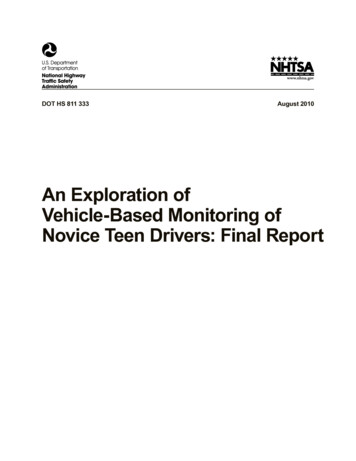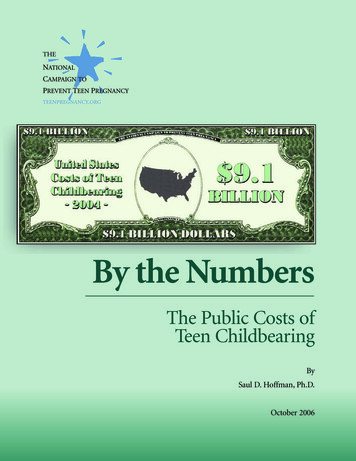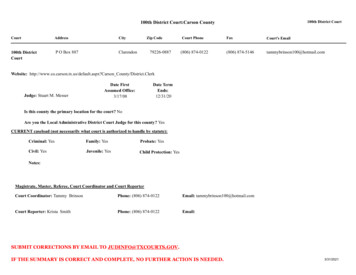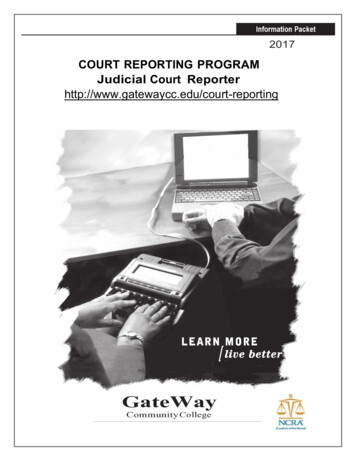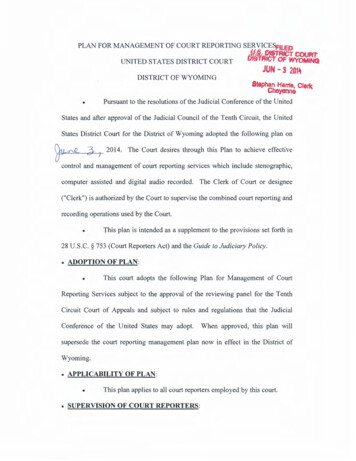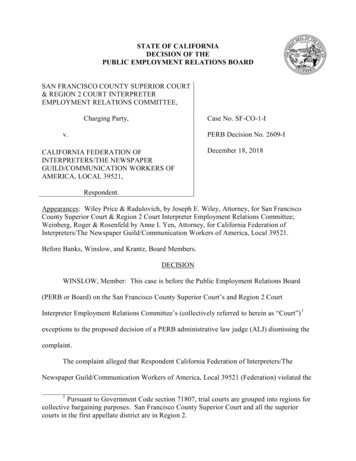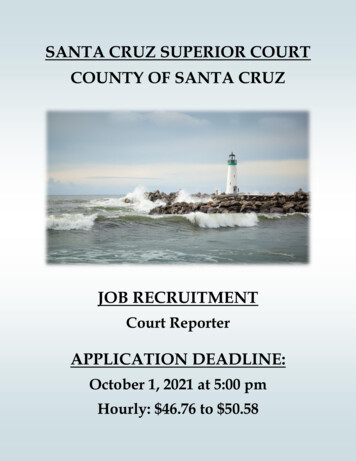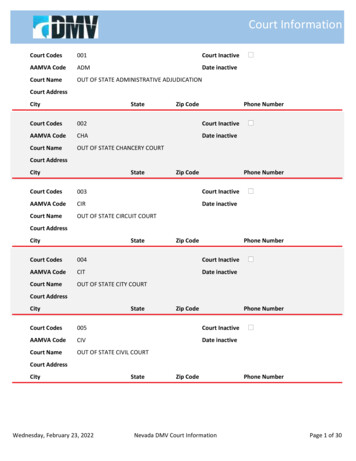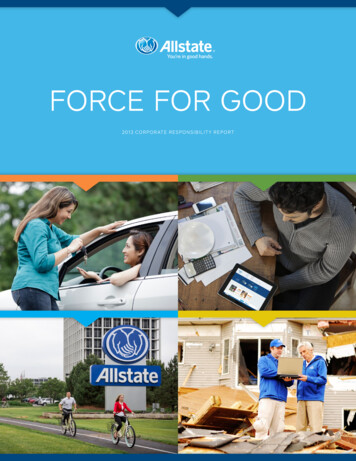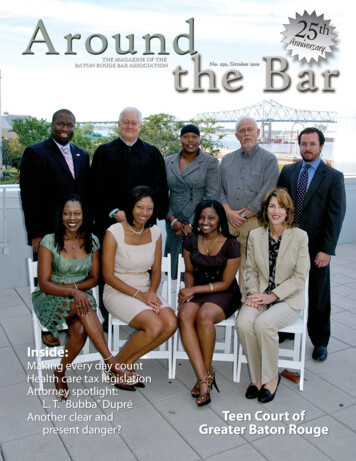
Transcription
th25AnniversaryInside:Making every day countHealth care tax legislationAttorney spotlight:L. T. “Bubba” DupréAnother clear andpresent danger?Teen Court ofGreater Baton Rouge
2Around the BarOctober 2010
insideOCTOBER 20104Contributors5Letter from the president“The test of time” BY FRED T. CRIFASI6Tales from the bar side“Looking back” BY VINCENT P. FORNIAS8Young lawyers report“Young Lawyers Section revises age limit for membership”BY JAMIE HURST WATTS9Attorney spotlight“Interview with L. T. ‘Bubba’ DupréOn the cover:This month’s cover photo features attorney and law studentvolunteers of the Teen Court of Greater Baton Rouge program11“2010 Tax Legislation: Health care reform (Part I)”BY WILLIAM C. POTTER, CPA, JD & BRANDON LAGARDE, CPA, JDof the Baton Rouge Bar Foundation.Photographed on the 4th floor River Terrace of the Shaw CenterBY NHI DINH14“Making every day count — 2009 changes to the Federal Rulesof Civil Procedure” BY BRANDI COLE17“A new clear and present danger: Security, freedom and ordered liberty onthe home front during the war against terrorism” BY BEAU JAMES BROCK21“Teen Court program enters its fifth year” BY NHI DINH22Bar news23Gail’s grammar24West’s Jury Verdicts - Baton Rouge25“BRBA Softball Tournament 2010 recap” BY ART VINGIELLO26Foundation footnotesfor the Arts building are (L to R, standing) Tavares Walker,Judge Darrell White (Ret.), Tomeka Gilbert, Weldon Hill II, BenChapman; (L to R, seated) Samantha R. Ackers, LaKeisha Gray,Trenisha Jackson and Barbara Baier. NOT PICTURED are TeenCourt Coordinator Donna Buuck and Teen Court AssistantCoordinator R. Lynn S. Haynes.Teen Court of Baton Rouge enters its fifth year as Around theBar celebrates its 25th anniversary. The magazine was firstpublished in September 1985.Cover photography by Pamela Labbe.Pierce & Associates, L.L.C.Providing Service for the Legal ProfessionCivil & Criminal InvestigationsAccident Investigation SurveillanceWitness StatementsJACK PIERCEOctober 2010PHONE: (225) 642-4030FAX: (225) 642-4009E-MAIL: jackpierce1@cox.netAround the Bar3
contributorsBeau James Brock, who practices environmental law and policyin his position of Assistant Secretary of Compliance at the LouisianaDepartment of Environmental Quality, is a contributing writer.Brandi Cole, an associate with Phelps Dunbar, LLP, is a contributing writer.Published by the Baton Rouge Bar AssociationP. O. Box 2241, Baton Rouge, LA 70821Phone (225) 344-4803 Fax (225) 344-4805Web site: www.brba.orgIn three years, the Baton Rouge Bar Association will be adiverse mix of young energy and old traditions in service tomembers, the community and the legal profession.OFFICERSFred Crifasi, President.766-0014Preston Castille Jr., President-elect.387-3221Gail S. Stephenson, Treasurer .771-4900, ext. 216Michael S. Walsh, Secretary .344-0474Trenton J. Oubre, Past President .387-4000Fred T. Crifasi, 2010 president of the BRBA, is a solo practitioner.Nhi Dinh served as the summer 2010 journalism intern for the BRBA.Vincent P. Fornias, an assistant editor of Around the Bar, is a solopractitioner whose practice focus is alternative dispute resolution.Pamela Labbe is the communications coordinatorof the Baton Rouge Bar Association.Brandon Lagarde, CPA, JD, an associate director with Postlethwaite &Netterville’s Tax Services Group, is a contributing writer.DIRECTORS AT LARGERobert “Bubby” Burns Jr.Amy LambertJeanne ComeauxDarrel PapillionKyle FerachiKarli Glascock WilsonCatherine S. Giering, Ex OfficioMelanie N. Jones, Ex OfficioSheri Morris, Ex OfficioABA DELEGATEErin Wilder-DoomesYOUNG LAWYERS SECTION OFFICERSCatherine S. Giering, Chairman .343-5290Amanda Stout, Chairman-elect .382-3693Jamie Hurst Watts, Secretary. .922-5110Kyle Ferachi, Past Chair .383-9000YOUNG LAWYERS SECTION COUNCILWilliam C. Potter, CPA, JD, managing director ofPostlethwaite & Netterville, is a contributing writer.Gail S. Stephenson, an assistant editor of Around the Bar,is the director of legal analysis and writing and an associateprofessor of law for the Southern University Law Center.Art Vingiello, a partner with Steffes, Vingiello & McKenzie,is a member of the Publications Committee.Jamie Hurst Watts, a partner with Long Law Firm, is thesecretary of the Young Lawyers Section of the BRBA.NINETEENTH JUDICIAL DISTRICT COURT PARISH OF EAST BATON ROUGESTATE OF LOUISIANABaton Rouge, Louisiana 70801NOTICE: Request for Volunteer MediatorsThe Civil Divisions of the 19th JDC are implementing a mediation program for civil cases in whichthe demand is below 30,000. We are seeking a panel of volunteers willing to accept up to three casesper year on a no-fee basis. Each mediation will be three hours in duration.Attorneys interested must possess the qualifications found in either La. R.S. 9:4106 A(1)(a) or A(2).Interested attorneys may contact Ann Gregorie Scarleat the BRBA Office at 225-214-5563 to obtain an application.AROUND THE BAR supports participation of the membership in its production. We encourage the submission of articles and letters tothe editor. Articles should be less than 1,800 words, typed and single-spaced. If possible, a Microsoft Word file should be e-mailed as anattachment to: pamela@BRBA.org.For advertising information call Pamela Labbe at 225-214-5560. Display ads should be e-mailed as an attachment as a .PDF, and classifiedads as text only. Publication of any advertisement shall not be considered an endorsement of the product or service involved. The editorreserves the right to reject any advertisement, article or letter.Copyright by the Baton Rouge Bar Association. All rights reserved. Reproduction in whole or part without permission is prohibited. Torequest permission or for more information, contact Pamela Labbe at 225-214-5560 or pamela@BRBA.org.4Around the BarElisabeth QuinnLaranda Moffett WalkerMichael J. BusadaScotty ChabertLyla N. DeBlieuxFAMILY LAW SECTIONMelanie N. Jones, Chair.344-2200Laurie Marien, Chair-elect .769-8500Wendy L. Edwards, Secretary. .387-1724Lisa Leslie Boudreaux, Past Chair .769-8500STAFFAnn Gregorie ScarleExecutive Director214-5563Donna BuuckEducation Coordinator214-5556R. Lynn S. HaynesAssistant Teen Court Coordinator214-5564Margaret JohnsonAdministrative Assistant344-4803Robin KayPro Bono Coordinator214-5561Susan KelleyOffice Manager214-5559Pamela LabbeCommunications Coordinator214-5560Carole McGeheeLawyer Referral Coordinator214-5557Trang NguyenPro Bono Coordinator214-5558Julie OursoBookkeeper214-5572PUBLICATIONS COMMITTEEEditor: Edward J. Walters Jr.— 236-3636Assistant Editors:Vincent P. Fornias — 769-4553Gail S. Stephenson — 771-4900, ext. 216Graphic Design / Ad Sales:Pamela Labbe — 214-5560Robert CollinsAmy E. CounceLani DurioKatie EckertRachel EmanuelGreg GounerMarshall GrodnerLexi HolingaKate Bailey LabueDale LeeJohn McLindonJennifer OrgeronDarrel PapillionGracella SimmonsArt VingielloJeff WittenbrinkMonika WrightAll Rights Reserved Copyright 2010October 2010
PHOTO BY JOHN CRIFASIletter fromthe presidentBY FRED T. CRIFASIThe test of timeGreat quotations stand the test of time. Everyone has heard, “It is better to keep silent andbe thought a fool than to speak and remove all doubt.” This one comes to mind every time Ibegin writing one of these articles. But since I can’t leave this page blank, allow me to sharesome recent reflections.Each day we should appreciate the distinct privilege we have to practice law. When clientstrust us with a matter, we not only gain the advantage of additional experience, we – veryhumbly – live a part of their lives with them. Whether it be a suit for damages or a businessdispute, it is a crisis for that person or organization. To guide that person along the best path isnot only an opportunity, but a serious obligation.“Only a fool learns from his own mistakes, a wise man from the mistakesof others.” As lawyers, we are paid to learn from others’ mistakes, or simplyput, to be wise.But wisdom doesn’t come without a learning curve. As Oscar Wilde putit, “Experience is the name we give to our mistakes.” Therefore, it is a hugegift from a client that allows us to live in his or her moment, to practice lawwith the facts of his or her case, and to then possess this gift for the benefit ofall future clients.We are doubly gifted as we cannot completely separate this experiencefrom our personal lives. I would suspect the family law practitioner knowsa lot of what to do — or what not to do — to be a good spouse, divorcee orparent.Corporate lawyers learn much about creating and operating an effectivebusiness. It is no wonder we often see lawyers hired by corporationssubsequently climb the corporate ladder. They bring their own experience plusthat of every client they have assisted.Fred T. CrifasiNo, criminal defense lawyers do not learn how to be better criminals.Rather, we get to learn an enormous amount about psychology, toxicology,pharmacology, pathology, sociology and even neurology, or, in simple terms — human nature.These were thoughts that came to mind after reading The Kings of Tort by Alan Langeand Tom Dawson. This is an astonishing book that recounts the investigation and prosecutionof Dickie Scruggs and others. Mr. Scruggs handled asbestos class action cases and was then alead attorney in the class action suits against the tobacco industry. He is said to have been, andperhaps still could be, a billionaire.Alan Lange is a political analyst and Tom Dawson is the Assistant United States Attorneythat led the prosecution of the case. These two present the very Southern and political backdropof the story as well as a detailed chronology of the cases.Lange and Watson will be our luncheon speakers Thursday, Nov. 4, 2010, at the CrownePlaza. Please join us.Some of you may personally know Mr. Scruggs or others discussed in the book. If youdo, you know the end of the story, or at least, the end so far. This presentation should notbe viewed as an opportunity to throw more stones, but the facts provide perhaps the mostextreme example of a supremely talented attorney completely losing sight of this great privilegebestowed upon us.October 2010Around the Bar5
tales fromthe bar sideBY VINCENT P. FORNIASA while back I received an e-mail titled “YourEntire Childhood Memories in One E-mail.” Talk aboutan ambitious title! The attached presentation featureditems such as S&H green stamps, metal ice cube trays,Falstaff beer and Ed Sullivan on Sunday nights. To mostof you “young” lawyers out there, the lion’s share of thePowerPoint display would go largely unrecognized or atleast underappreciated.I have been informed that this is the 250th printing ofthis publication, a time to reflect upon and appreciate ourpast. And in borrowing on this ambitious e-mail theme,I sat back and thought about the many lawyers in ourextraordinary Association who are no longer with us,but who through some wonderful stroke of fate crossedmy own path over the last three-plus decades, each in hisown way, leaving me an indelible example of lawyeringin Baton Rouge. My personal PowerPoint of lawyers pastwould include:Looking backThe community spirit of Gordon Pugh.The passion of Athena Piedrahita.The practical sense of Ben Guelfo.The credibility of Bob Vandaworker.The gentility of Gordon Kean.The compassion of Judge Leon Hebert.The thoroughness of Calvin Hardin.There are doubtlessly scores of others just as deservingof my personal PowerPoint that have gone unmentioned.For that, I sincerely apologize. My simple wish for eachand every “young” lawyer of our group, as we celebrateour 250th issue, is that you will one day come to treasure,as I have, the precious legacy, a venerable tapestry, of thoseno longer with us who made you a far better professionalsimply for having known them.The competitiveness of Jack AvantThe humor of Burt Garraway.The courtroom demeanor of WaltonBarnes.The quiet strength of Norbert Rayford.The innate optimism of Judge CarlosSpaht.The creativity of Bruce Macmurdo.The integrity of Judge Harvey Posner.The meticulous preparation of DavidRobinson.The sense of fair play of FrankMiddleton.The generosity of David Hamilton.The humility of Byron Kantrow, Sr.The ingenious simplicity of ArthurCobb.The trial instincts of Roger Fritchie.The balanced view of John Thibaut.The people skills of Rodney Ryan.6Around the BarOctober 2010
2011 Baton Rouge Bar AssociationBench Bar ConferenceApril 28-30Featuringthe BenjyDavisProjectGrand Hotel Marriott Resort, Golf Club & Spa in Point Clear, Ala.For more information, contact Ann G. Scarle: 225-214-5563 / ann@brba.orgThe Young Lawyers SectionHoliday Star ProjectSign up to sponsor a child. Please fill out the form below and fax it tothe Bar office at (225) 344-4805. The Baton Rouge Bar Foundationis tax-exempt as a charitable organization by the Internal RevenueService under section 501(c)(3) of the IRS Code.Name:Firm:Address:City: State: Zip:Phone: Fax:E-Mail: # of stars you wish to sponsor:Make a child’s wish come true this holiday season! Fill out this form and fax it to the BRBA office at 225-344-4805.The Baton Rouge Bar Foundation will mail your star and child’s wish list with instructions to you.Questions? Please call Susan Kelley at (225) 214-5559.October 2010Around the Bar7
young lawyersreportBY JAMIE HURST WATTSAt the May 5, 2010, regular meeting of Young LawyersSection Council of the Baton Rouge Bar Association, thecouncil members voted unanimously to amend the bylaws of the Young Lawyers Section to change the age limitfor membership.Section 2.1 of the by-laws formerly provided thatall lawyers 36 and under or who have been admitted totheir first Bar for five years or less, and who pay any duesas set and assessed by the Board of the BRBA, may bea member of this Section. The Young Lawyers SectionCouncil approved an amendment to Section 2.1 thatextends eligibility for membership in the Section to alllawyers 39 and under or who have been admitted to theirfirst Bar for five years or less, and who pay any dues as setand assessed by the Board of the BRBA. Likewise, Section8Around the BarYoung Lawyers Section revisesage limit for membership2.2 of the by-laws formerly provided for termination ofmembership automatically at the end of the calendar yearwithin which a member attains 36 years of age or fiveyears after admission to his or her first Bar, whichever lastoccurs.The Young Lawyers Section Council approvedan amendment to Section 2.2 to allow for automatictermination of membership at the end of the calendaryear within which a member attains 39 years of age orfive years after admission to his or her first Bar, whicheverlast occurs.The revised age limit for membership in the BRBAYoung Lawyers Section is consistent with the age limits formembership in the Young Lawyers Section of the LSBAand the Young Lawyers Division of the ABA.October 2010
attorneyspotlightBY NHI DINHInterview withL.T. “Bubba” DupréPHOTO BY PAMELA LABBEL.T.“Bubba”DupréAccording to Dupré, beingwitnessed nuclear weapons,in the Navy not only taughtnorthern lights, air shows withhim the discipline to excel inlive munitions and 40-foot wavescollege, but it also gave him aall before his 21st birthday.multitude of experiences andDupré, who grew up inexposed him to people from allsmall-town Opelousas, La., tookwalks of life, allowing him tothe unconventional route tobring life to his classes.becoming a lawyer. He decidedAt the urging of his attorneyto sign up for the U.S. Navyfriends and family members,immediately after completingDupré entered law school at thehigh school. He described hisage of 32. As the only son of aexperience abroad as “pretty coolteacher and a nurse, Dupré hadstuff for a kid from St. Landryno idea how the law worked.Parish who, before graduatingHowever, he did possesshigh school, had never been northwhat his friends and familyof Georgia.”described as “a sharp tongue,From 1988 to 1990, Dupréa big mouth, a hard head, aserved active duty on an aircraftgood heart and a fundamentalcarrier with two Mediterraneandistrust of authority.”deployments. While abroad, heAfter Dupré graduatedmet Pope John Paul II and shookfrom the LSU Paul M. HebertL.T. “Bubba” Dupréthe hand of a sitting president.Law Center in 2004, he workedDuring his two years in the Navy,as a law clerk for a year underDupré saw most of Western Europe twice — making it theJudge James Genovese, familiarizing himself with the insmost exciting time of his life up to that point.and outs of procedures and trial practice. Dupré mentionedAfter his Navy discharge, Dupré attended LSU andthat there were other very valuable and practical tools hegraduated in May 1995 with a bachelor’s degree inlearned, such as never upsetting court staff, even whensecondary education social studies.they are wrong.By August 1996, he had a teaching and coachingFollowing his year as law clerk, Dupré workedposition at West Feliciana High School. Dupré coachedin various firms, government agencies and as a solobaseball and football while teaching Civics, Worldpractitioner before to forming Perkins & Dupré, AttorneysGeography and U.S. History. He obtained a master’sand Counselors at Law, LLC, with Clayton Perkins indegree in educational administration and supervisionJanuary 2008.while employed there.Dupré has been a member of the Baton Rouge BarAssociation since 2005. He volunteers for Ask-A-Lawyerworkshops and is a member of the LRIS Committee andSAVE THE DATEthe Lawyer Referral Panel. Even though he is an attorneynow, Dupré still teaches. This fall, he is teaching catechismat St. John the Baptist Catholic Church.From 8 a.m. to 5 p.m. at The Crowne Plaza Hotel in Baton RougeDupré spends his free time with his wife Staceyanddaughters Anna and Amelia. They currently live inThursday, Dec. 9 Friday, Dec. 10Zachary, La. Although he’s no longer in the Navy, he stillThursday, Dec. 16 Friday, Dec. 17finds time to travel. Dupré and his family go to the GulfWednesday, Dec. 29 Thursday, Dec. 30Coast every summer. He said, “If there’s a better life outthere, I don’t know about it.”FOR MORE INFORMATION,CALL 225-344-4803.CLE BY THE HOUR:October 2010Around the Bar9
Twelfth Annual“Belly Up with the Bar” Entry FormCook-off&BrewfestEvent takes place Friday, Oct. 22, 2010WHAT IS IT:The Twelfth Annual “Belly Up with the Bar” is a cook-off, brewfest and outdoor party with live music—sponsored by the YoungLawyers Section of the Baton Rouge Bar Association. Proceeds from this event will benefit the BRBF’s Youth Education Program.Team and individual entries are welcome. Judges will select winners in a variety of categories. Advance general admission ticketsare 20 per adult, 15 per law student, 10 per child ages 7 to 12, and admittance is FREE for children ages 6 and under. Prices atthe door are 25 per adult or law student, and 10 per child, so buy ’em now!WHEN & WHERE: The location is 6513 Perkins Rd., in the lot behind the law offices of Moore, Thompson, Lee & Broyles.The date is Friday, Oct. 22, 2010, 5 p.m. - until — mark your calendars NOW!WHO CAN ENTER: Anyone who’s willing to cook and serve enough to feed/water our local bar The entry fee is the same as the general admission fee - 20 per team member Teams can consist of 1 to 5 members The entry fee gets you (1) in the door to try all the fabulous food and drinks, (2) all the beer you care to drink, and(3) the chance to show off your culinary talentsTHINGS YOU’LL NEED TO BRING: Enough food to serve roughly 300 “sample size” portions Any cooking/heating/brewing equipment necessary to serve your entry A team of no more than 5 members A sign to indicate what you’re making and who’s on your teamTHINGS WE’LL PROVIDE:Plastic serving bowls, forks, spoons and cups; Beer, food, live music. . . and fabulous prizesENTRY FORMPLEASE FILL OUT THIS FORM AND FAX IT TO: (225) 344-4805 OR MAIL IT ASAPTo: Baton Rouge Bar Association, ATTN: YLS, P. O. Box 2241, Baton Rouge, LA 70821.(CHECKS SHOULD BE MADE PAYABLE TO “BRBF - BELLY UP WITH THE BAR.” CREDIT CARD INFORMATIONCAN BE PROVIDED BELOW.) Booths are assigned as forms and payment are received, so submit your form early!TEAM NAME:WHAT YOU’LL BE COOKING:TEAM MEMBERS:(1)CAPTAINFOR OFFICE USE ONLYTicket #CONTACT NUMBER & E-MAIL:(2)Ticket #(3)Ticket #(4)Ticket #(5)Ticket #FOR “BELLY UP WITH THE BAR” TICKET INFORMATION, PLEASE CONTACT THE BRBA AT (225) 344-4803.*If you are unable to participate or attend, but you wish to make a donation for the BRBF’s award-winning Youth Education Program, please make your check payable to the BRBF.Credit Card Information: Type of card: (circle one) MC VISA AmExpName on card:Exp. Date:Security code:Credit card number:Signature:10Around the BarOctober 2010
2010 TAX LEGISLATION:HEALTH CARE REFORM (PART I)BY WILLIAM C. POTTER, CPA, JD & BRANDON LAGARDE, CPA, JDHealth care reform finallypassed, but the result maynot be what many of thereformershadenvisioned.The avowed goal of universalcoverage gave way to a politicalsolution that changes insurancecoverage through interaction ofindividuals, employers, the IRSand other government agencies.It is imperative for attorneys tounderstand the impact health care reform has on theirown businesses as well as how it affects their clients.The two reform acts, the Patient Protection andAffordable Care Act, signed March 23, 2010, and theHealth Care and Education Affordability ReconciliationAct, signed March 30, 2010, combine for more than 2,000pages of legislation, with more regulations and guidanceto come.These acts attempt to modify health care coveragethrough mandates, incentives, taxes and penalties. Healthcare reform is phased in over a period of time spanning2010 through 2018. Due to the large quantity of changesto take effect, this article will address only those that takeeffect in 2010 and 2011; part II will discuss the changesthat take effect in future years. Here are several changesthat result from the signing of these two acts.Small employer tax creditEffective for the 2010 tax year, qualified smallbusinesses may receive an income tax credit for amountsthey pay for employee health coverage. “Qualified smallbusinesses” are employers who have 25 or fewer full-timeemployees and whose employees have wages averagingno more than 50,000 per year. The amount of the creditdiffers based on the number of employees and their averagewages. Employers could be eligible for up to 35 percentof non-elective contributions they make on behalf of theiremployees. The IRS has recently issued guidance to makeit easier for small businesses to determine whether they areeligible for the new health insurance tax credit. Not-forprofit entities may be entitled to a 25 percent credit againsttheir payroll taxes for their qualified employees.CLASS ActThe Community Living Assistance Services and Support(CLASS) Act is a voluntary, federally administered longOctober 2010tetermcare insurance plan thatwill be effective at the beginningwof next year. For those employedby an employer who chooses toparticipate, the employer willpaenroll employees automatically,enwith premiums handled throughwpayroll deduction, like otherpabenefits. Any employee maybechoose to opt out. The planchwill pay a cash benefit of nowless than 50 with the actual amount varying accordingto the individual’s ability to function. Those who requireassistance for more than one activity of daily living (ADL),such as eating, toileting, bathing or dressing, will receivea greater benefit amount. Participants are required to paypremiums for five years and be actively at work for threeof these years before they receive any benefits. Participantscan expect their premium to be between 125 and 150each month, and employers may pay some or all of thispremium. There is no lifetime cap on the benefits.Automatic enrollmentEffective March 23, 2010, employers with more than200 full-time employees and who offer enrollment in oneor more health benefit plans must automatically enrollnew employees in one of the offered plans. New employeesmust be given notice of their enrollment, and they must begiven the opportunity to opt out of coverage.No more over-the-counter reimbursementsBeginning Jan. 1, 2011, over-the-counter medicationswill generally no longer be reimbursable from healthreimbursement accounts (HRAs), health savings accounts(HSAs), medical savings accounts (MSAs) and flexiblesavings accounts (FSAs). A 20 percent tax may apply toimproper reimbursements.Simple cafeteria plans“Simple cafeteria plans” will be available, beginningJan. 1, 2011, to small employers having an average of 100or fewer employees for the two preceding years. Employerswho initially qualify can grow to up to 200 employeesand still be eligible. Simple cafeteria plans are requiredto make a contribution to provide qualified benefits onbehalf of each qualified employee in the amount of noless than two percent of the employee’s compensation forAround the Bar11
the year. An employer may choose to exclude from theplan (1) employees who are not yet 21 years of age, (2)employees who have less than one year of service withthe employer or (3) employees who are covered under acollective bargaining agreement.No more pre-existing condition exclusionsThe Patient Protection and Affordable Care Acteliminates the pre-existing condition requirements imposedby health plans. Effective Sept. 23, 2010, children underage 19 with pre-existing conditions may not be deniedaccess to their parents’ health insurance. This provisionwill apply to adults as well beginning in 2014.W-2 reportingBeginning in 2011, employers must disclose theaggregate cost of employer-provided health insurancecoverage provided to employees annually on the employee’sW-2. This includes coverage under any group health plan,such as medical, prescription, dental and vision, but doesnot include any salary contributions to a flexible spendingaccounting (FSA) or health savings account (HSA). Thisis informational reporting only and does not increasetaxable wages. These rules apply to 2010 W-2s.12Around the BarDependent coverage expandedEffective for plan years beginning on or after Sept. 23,2010, several changes must be included in any employerbased plan that is not a “grandfathered plan.” For example,plans will have to allow for coverage of an employee’sdependents up to age 26, even if they are married.“Children” can be defined as a son, daughter, adoptedchild, stepchild or eligible foster child. This provision isestimated to add coverage for 1,250,000 young adults,and as a result, health plans may start pricing per head.Grandfathered plansThose enrolled in a group health plan or have individualhealth coverage in existence as of March 23, 2010, arenot required to change their coverage terms, except fora few mandated benefits. These plans are exempt frommany of the provisions of new plans, such as coverage ofpreventive care, nondiscrimination rules, claims appealsprocedures, transparency requirements, ensuring qualityof care, fair health insurance premiums, prohibition ondiscrimination against providers and the requirement toprovide essential benefits. It is also important to note thatalthough the law does not require individuals to terminatetheir existing coverage, the law also does not prevent agroup health plan or insurance coverage from droppingthose grandfathered plans.October 2010
No more lifetime or annual coverage capsIndividual and group health insurers may no longerimpose benefits caps. Lifetime limits on the dollar valueof benefits for either participants or beneficiaries are nowspecifically prohibited. Annual limits on the dollar valueof benefits for either participants or beneficiaries arealso prohibited, with the exception of some reasonablerestrictions for plan years prior to 2014.this issue, newly enacted Section 7701(o)(1) of the InternalRevenue Code clarifies that the economic substancedoctrine involves a two-part conjunctive analysis of: (1)the objective effects of the transaction on the taxpayer’seconomic position and (2) the taxpayer’s subjectivemotives for engaging in the transaction. A 20 percentpenalty applies to any transaction that is determined tolack economic substance.Medicare Part DCurrently, Medicare Part D does not offer coverage forprescription drugs between 2,830 and 4,550. However,certain provisions are slowly closing the donut hole. For2010, those incurring donut hole expenses will receive a 250 rebate. For 2011, there will be sliding coinsuranceavailable for both generic and brand name prescriptions.If you haven’t already begun to see the effects ofthe Patient Protection and Affordable Care Act or theHealth Care and Education Affordability ReconciliationAct, the next several years will bring several changes forindividuals, employers and other organizations.Codification of the economic substance doctrineThe “economic substance” doctrine is a common lawdoctrine that has developed over the years to deny taxbenefits generated from transactions that do not result ina meaningful change to the taxpayer’s economic positionother than the reduction in federal income tax. Prior tocodification, there was a lack of uniformity among thecircuits regarding the proper test to use when applying theeconomic substance doctrine. In an attempt to clear upOctober 2010lEarn your CLE locallyThe BRBA offers lots of optionsto help you fulfill your CLE requirements.THE NEXT AVAILABLE CLE SEMINAR IS:Demonstrative Evidence ClinicFriday, Oct. 29, 20108 a.m.-12 p.m. — Middleton Bar Center, 544 M
Published by the Baton Rouge Bar Association P. O. Box 2241, Baton Rouge, LA 70821 Phone (225) 344-4803 Fax (225) 344-4805 Web site: www.brba.org In three years, the Baton Rouge Bar Association will be a diverse mix of young energy and old traditions in service to members, the community and the legal profession. OFFICERS
